Section 4: Sample Selected-Response Questions Art EC–12 (178)
Expand All Answers | Collapse All Answers
This section presents some sample exam questions for you to review as part of your preparation for the exam. To demonstrate how each competency may be assessed, sample questions are accompanied by the competency that they measure. While studying, you may wish to read the competency before and after you consider each sample question. Please note that the competency statements do not appear on the actual exam.
For each sample exam question, there is a correct answer and a rationale for each answer option. The sample questions are included to illustrate the formats and types of questions you will see on the exam; however, your performance on the sample questions should not be viewed as a predictor of your performance on the actual exam.
Domain I—Creating Works of Art
Competency 001—The teacher demonstrates knowledge of the elements and principles of art and analyzes their use in works of visual art.
To answer the following question, please refer to the image of Romare Bearden's Sunday After Sermon, reproduced below.
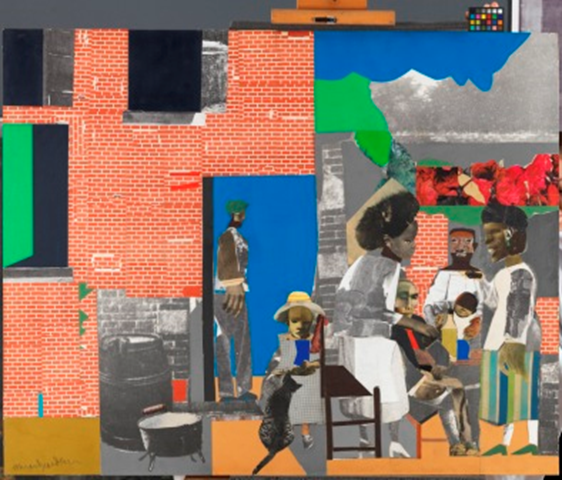
The image presents a collage on cardboard, Sunday After Sermon by Romare Bearden. The work is large, approximately 40 by 50 inches in size. The collage shows a city street scene viewed from curbside, with numerous figures positioned along the sidewalk in front of house exteriors. In the right bottom quadrant, a group of African Americans, presumably neighbors, are shown chatting together after the weekly church service. The figures are positioned against a background of mostly rectangular paper shapes representing brick walls, doorways, and windows of houses that border the street. Every feature—sidewalk, houses, people—has been carefully pieced together using images from newspaper, magazine, and catalogue clippings, reproductions of works of art, and small pieces of painted paper. For the face of a figure, the artist might use fifteen different magazine cuttings. Patterns, shapes, textures, and bright flat colors such as green, blue, and brick red are incorporated evenly throughout the work.
1. In the work, the sense of a balanced composition is primarily created by the
- strategic placement of shapes, colors and textures.
- juxtaposition of photographs and paper as collage elements.
- use of paint to heighten contrast.
- repetition of young and old faces of African American people.
- Enter to expand or collapse answer.Answer expanded
- Option A is correct because Bearden has manipulated shapes (such as the geometric buildings and the figures), colors (such as the strong reds, blues and greens) and textures (such as the bricks and the solid, flat colors) to create a balanced composition. Option B is incorrect because the photographs appear primarily in the lower right of the painting. Option C is incorrect because the sense of balance involves all aspects of the work, not just paint and contrast. Option D is incorrect because the repetition of faces is also found primarily in the lower right of the work.
To answer the following question, please refer to the image of a color wheel, reproduced below.
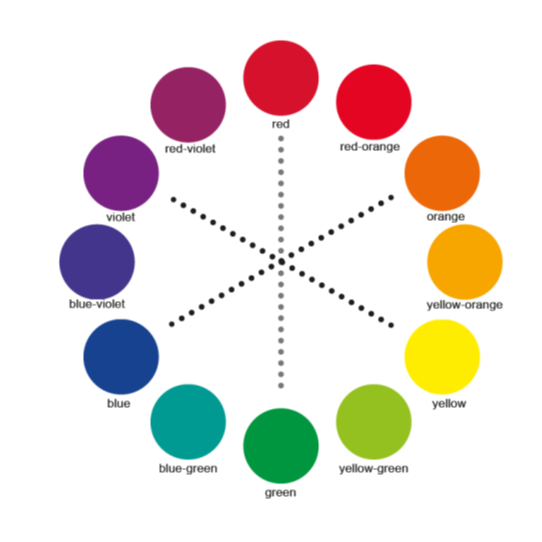
The image presents the color wheel. Starting at the top and moving clockwise, the colors are as follows: red, red-orange, orange, yellow-orange, yellow, yellow-green, green, blue-green, blue, blue-violet, violet, red-violet. There is a dotted line from red to green, from orange to blue, and from violet to yellow.
2. The wheel shown depicts the relationship between primary and secondary
- hues.
- tints.
- tones.
- accents.
- Enter to expand or collapse answer.Answer expanded
- Option A is correct because “hue” refers to the colors of the visible spectrum, with names such as blue, violet, and red, which commonly comprise a standard color wheel. Option B is incorrect because a tint is a color mixed with white. Option C is incorrect because a tone is a mixture of a color with gray. Option D is incorrect because accent colors only exist in relation to a color scheme and may include colors not included in the color wheel, such as black.
3. A color's intensity is a basic property best defined as its relative
- warmth or coolness.
- dullness or brightness.
- lightness or darkness.
- opacity or transparency.
- Enter to expand or collapse answer.Answer expanded
- Option B is correct because intensity, a basic property of color, refers to relative brightness. Option A is incorrect because warmth and coolness are not directly related to a color's intensity. Option C is incorrect because lightness and darkness best define a color's value, not its intensity. Option D is incorrect because a color's opacity and transparency may operate independently of color intensity.
4. In a still life composition, the figure ground relationship generally corresponds to the relationship between which of the following?
- Small and large scale
- Static and dynamic balance
- Simple and complex shape
- Positive and negative space
- Enter to expand or collapse answer.Answer expanded
- Option D is correct because figure-ground relationships, as defined by Gestalt principles of visual perception, correspond most closely to the concept of positive and negative space in the field of vision. Options A, B, and C are incorrect because they refer to other visual concepts not commonly associated with figure-ground relationships.
Competency 002—The teacher understands the tools, materials, processes and techniques used in drawing.
5. Which of the following drawing media offers the most limited range of values for rendering?
- Graphite stick
- Conté crayon
- Vine charcoal
- Compressed charcoal
- Enter to expand or collapse answer.Answer expanded
- Option C is correct because vine charcoal is usually made simply from carbonized wood sticks or vines and, although it may be available in a few different hardness grades, characteristically provides a light mark that easily smudges and erases. Consequently, vine charcoal is traditionally used for preliminary sketches and underdrawings but would not be a useful selection for rendering form since the range of values is limited. Options A, B, and D are incorrect because they all refer to drawing media that are commercially manufactured to provide a wide range of varying degrees of hardness that is more appropriate for creating artwork using value to describe form.
6. Of the following locations, it is safest to use spray fixative in
- a classroom that has open windows.
- an air-conditioned hallway.
- an unused basement space.
- an open-air courtyard.
- Enter to expand or collapse answer.Answer expanded
- Option D is correct because spray fixative is toxic; when a drawing is sprayed with fixative, it should be done in open air if at all possible. Options A, B, and C are incorrect because none of them would supply sufficient ventilation for safe use of the fixative.
7. Which TWO of the following terms refer to types of line?
- Contour
- Doodle
- Hatched
- Cartoon
- Positive
- Enter to expand or collapse answer.Answer expanded
- Options A and C are correct because “contour” and “hatched” are standard descriptions for types of lines; contour refers to line used to draw the perceived outer edge of a form and hatched refers to line that is used in parallel groups to model a form. Options B, D, and E are incorrect because their meanings are not related to types of line.
Competency 003—The teacher understands the tools, materials, processes and techniques used in painting.
8. Which TWO of the following are commonly used with watercolor paint?
- Soft brushes
- Salt
- Squeegees
- Gel medium
- Gesso
- Enter to expand or collapse answer.Answer expanded
- Options A and B are correct; soft brushes are generally used with watercolor paint because they create fewer marks in the paint than stiff brushes would and salt is often used because when it is sprinkled on wet watercolor paint, the crystals absorb some of the water and create patterns. Option C is incorrect because a squeegee is a tool used for silk-screen printing (serigraphy). Options D and E are incorrect because neither is commonly mixed with watercolor paint.
9. Which of the following terms refers to a blue pigment?
- Vermillion
- Ultramarine
- Umber
- Chrome
- Enter to expand or collapse answer.Answer expanded
- Option B is correct because ultra marine is a blue pigment. Options A, C, and D are incorrect because they refer to pigments that make other colors.
To answer the following question, please refer to the image of Vincent van Gogh's The Potato Eaters, reproduced below.
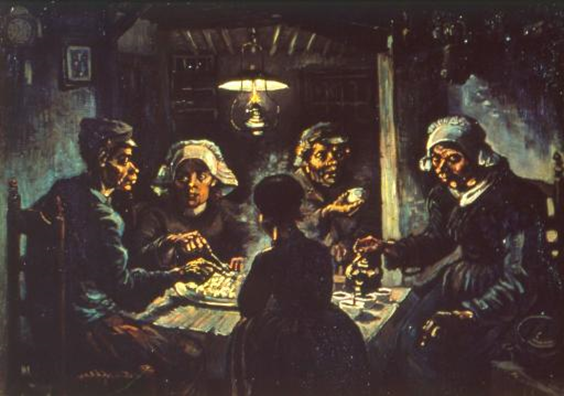
The image presents a painting, The Potato Eaters by Vincent van Gogh. The scene shows a poor peasant family sitting around a square-shaped wooden table made of worn planks, sharing their humble evening meal of potatoes. A man and woman on opposite ends of the table face each other, another woman and man are seated close together behind the table, facing the viewer, and a female figure is seated at the front of the table with her back to the viewer. All of them are wearing either caps or kerchiefs, and long, thick clothing. The woman on the extreme right of the painting is pouring what appears to be coffee from a teapot into small cups sitting on the table. On the viewer’s left, the gnarled hands with bony fingers of a man and woman reach out to spear cooked potatoes from a large platter. The subject matter is rendered realistically, with broad brushstrokes, a drab color palette, and strong light and dark contrast throughout the composition. An oil lamp hanging from the beams of the ceiling above the dining table is the only light source, and it illuminates the room and the figures, creating a pool of warmth within the cramped, dark space. The light creates strong shadows in the figures’ faces and surroundings. The outer edges of the painting, which are built up of darker shades, contrast sharply with the areas lit by the oil lamp.
10. In an analytical classroom discussion of van Gogh's early painting The Potato Eaters, which of the following conclusions would be logical?
- The drawing and features of the figures suggest the family's hard life.
- The color palette prefigures the colors in van Gogh's later well-known works.
- The position of the child suggests that she is unimportant in the family.
- The use of a single light source suggests that van Gogh had not yet mastered the depiction of light.
- Enter to expand or collapse answer.Answer expanded
- Option A is correct because van Gogh has drawn the figures to show, for example, that they have worked hard as their hands indicate; the expressions also suggest fatigue. Option B is incorrect because van Gogh generally moved toward a lighter and more varied palette as his work matured. Option C is incorrect because there is nothing in the composition to support it. Option D is incorrect because the single light source is used effectively to create a dramatic light that heightens the drama of the scene.
Competency 004—The teacher understands the tools, materials, processes and techniques used in sculpture and ceramics.
To answer the following question, please refer to the image of Melvin Edwards' The Fourth Circle, reproduced below.
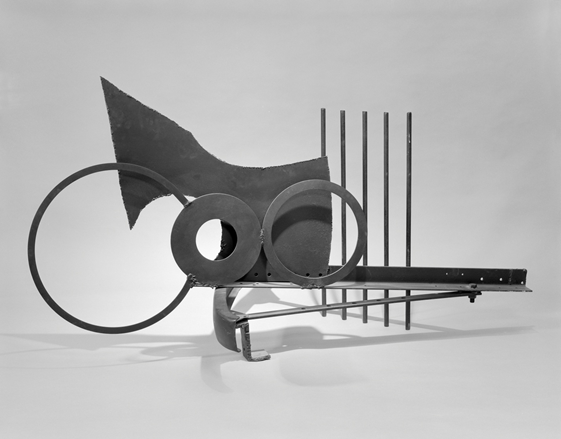
The image presents The Fourth Circle, a painted steel sculpture created in 1966 by the contemporary sculptor Melvin Edwards. The dimensions are approximately 4 feet high, 6 feet wide, and 5 feet deep. Using found steel objects, different kinds of steel, and simple geometric shapes like lines, circles, squares, and rectangles, Edwards welded a kind of sculptural collage. Edwards assembled the sculpture using forge welding with a hammer to join metal to metal and bolting together the resulting disparate components. The work is shown in side view, which flattens space and emphasizes the shapes and contours. Within the composition, three distinct circles are noticeable. The fourth circle alluded to in the title is the negative space formed by the partially cutout circle in the large, curvilinear, abstract shape in the approximate center. The entire sculpture is painted with matte black paint.
11. After critiquing Melvin Edwards' steel sculpture, tenth-grade students correctly deduce that the artist's choice to cover all surfaces with matte black paint has which TWO of the following effects?
- Variety is enhanced.
- Shapes are emphasized.
- Components are unified.
- Textures are obscured.
- Space is deepened.
- Enter to expand or collapse answer.Answer expanded
- Options B and C are correct. By using a single matte color — as opposed to a variety of colors on the piece or a combination of colors within a single shape — Edwards emphasizes the contour of each shape. The fact that the color is black also helps to make each shape stand out like a silhouette, whether it is the irregularly shaped large piece or any of the geometric shapes in the work. In addition, the use of a single color helps to unify the work, causing the black verticals to be perceived as a cohesive group, for example, and providing a means of unifying all of the work's components. Option A is incorrect because the matte black paint de-emphasizes variety, rather than enhancing it. Option D is incorrect because the paint has no particular effect on the texture of the piece, which appears to be uniform. Option E is incorrect because the uniform flat color does not create an effect of deep space.
12. Which of the following techniques is commonly used in ceramics?
- Chasing
- Embossing
- Scoring
- Etching
- Enter to expand or collapse answer.Answer expanded
- Option C is correct because scoring means scratching marks into moist clay when joining two pieces. Options A, B, and D are incorrect because they do not refer to ceramic processes.
Competency 005—The teacher understands the tools, materials, processes and techniques used in fiberart and jewelry.
13. The material that is used as the center layer of a quilt is known as
- backing.
- felting.
- smocking.
- batting.
- Enter to expand or collapse answer.Answer expanded
- Option D is correct because the middle layer of a quilt is known as batting. Option A is incorrect because backing refers to the fabric used on the reverse side of a quilt. Option B is incorrect because it refers to the process of compressing fibers to form a dense material. Option C is incorrect because smocking is a decorative stitchery technique.
To answer the following question, please refer to the image of the carved gem, reproduced below.
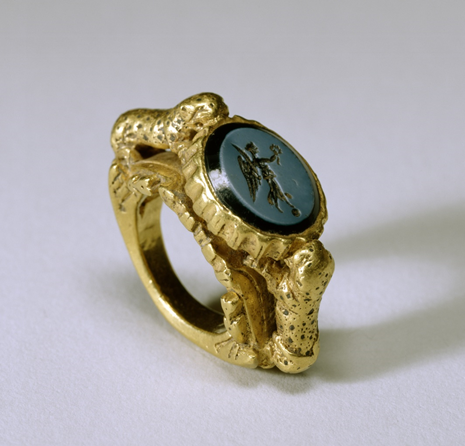
The image presents a Byzantine gold ring set with a flat blue-grey stone, viewed in an upright, three-quarters view. The circular gem, a form of onyx, has a reverse-carved, full-length portrait of the goddess Nike (victory) in its center. The goddess appears as a delicate figure with wings, wearing a diaphanous dress, standing on an orb and holding a wreath in her outstretched hand. The bezel holding the stone is almost completely separated from the hoop and is held up by a pair of leopards.
14. Which of the following is a jewelry-making method in which a design is reverse carved into a gemstone such as the blue onyx gem shown?
- Intaglio
- Inlay
- Cameo
- Scrimshaw
- Enter to expand or collapse answer.Answer expanded
- Option A is correct because the process of reverse carving a sunken design into the surface of a gemstone is known as intaglio, which is also the term for the engraved gem itself. Option B is incorrect because scrimshaw refers to the carving of shallow intricate designs into the surface of whale ivory. Option C is incorrect because the cameo method refers to the carving of a gem or shell in raised relief, the opposite of the intaglio technique. Option D is incorrect because inlay refers to the method of embedding a contrasting material into an object, flush with the surface, to form a pattern or design.
15. Which of the following textile techniques uses a type of resist dyeing?
- Ombré dip dye
- Transfer printing
- Reverse appliqué
- Shibori tie dye
- Enter to expand or collapse answer.Answer expanded
- Option D is correct because shibori tie-dye is a technique of resist dyeing that involves tying, folding, sewing, or pleating sections of fabric to tightly bind and resist dye in order to achieve a desired intricate pattern. Options A, B, and C are incorrect because none of these techniques requires any form of resist dyeing.
Competency 006—The teacher understands the tools, materials, processes and techniques used in printmaking and photography.
16. Before creating a final edition of a print, a printmaker typically makes which of the following to ensure that the plate is printing as it should?
- A maquette
- A monoprint
- A patina
- A proof
- Enter to expand or collapse answer.Answer expanded
- Option D is correct because a proof is a test print that is made before creating the final edition of a print. Option A is incorrect because a maquette is a small model of a sculpture. Option B is incorrect because monoprinting is a printmaking technique. Option C is incorrect because patina refers to a thin layer that can form on many materials that are old or exposed to air.
17. In digital photography, a histogram is used to gauge which of the following?
- History brush
- Tonal range
- Diopter adjustment
- Shutter speed
- Enter to expand or collapse answer.Answer expanded
- Option B is correct because the histogram is used to gauge the tonal, or dynamic range, of an exposure. Option A is incorrect because the history brush is a photo editing tool. Option C is incorrect because the Diopter adjustment is used to focus the viewfinder. Option D is incorrect because a histogram does not measure shutter speed.
Competency 007—The teacher understands the tools, materials, processes and techniques used in electronic and other contemporary art forms (e.g., performance art, videography).
18. If an artist appropriates an image from the Internet to incorporate in a digital work, it is most easily defensible for the artist to
- copy the image exactly, without alteration.
- research how often the image has been reproduced already.
- use an old image that no longer has copyright protection.
- choose an image that is not widely known.
- Enter to expand or collapse answer.Answer expanded
- Option C is correct because images that no longer have copyright protection may be reproduced freely. Options A, B, and D are incorrect because any of those actions by itself will not necessarily provide information about copyright protection and may result in copyright infringement.
19. An art installation that includes looped film and sound elements is best described as which of the following?
- Endurance based
- Process based
- Product based
- Time based
- Enter to expand or collapse answer.Answer expanded
- Option D is correct because film and audio elements unfold in time. An installation that includes these elements is, by definition, time based. Options A, B, and C are incorrect because each would not necessarily include film or audio elements.
Domain II—Art, Culture and History
Competency 008—The teacher understands how the visual arts shape and reflect history and different societies.
20. Traditional African Kente cloth consists of geometric patterns and vibrant colors that are
- derived from unknown sources.
- intended to be purely decorative.
- associated with creation mythology tales.
- meant to symbolize valued societal concepts.
- Enter to expand or collapse answer.Answer expanded
- Option D is correct because handwoven Kente cloth, associated with the Ashanti people of Ghana and Côte d'Ivoire, is notable for elaborate patterns and colors that denote specific meanings that date back centuries, originating in ancient Akan society. Option A is incorrect because the patterns and colors of Kente cloth are not derived from unknown sources. Option B is incorrect because Kente cloth designs are associated with societal meaning and are not purely decorative. Option C is incorrect because Kente cloth designs denote broad societal meanings, not simply creation mythology tales.
21. The statue of David by Michelangelo became a symbol of the defense of civil liberty for which of the following cities?
- Milan
- Florence
- Athens
- Rome
- Enter to expand or collapse answer.Answer expanded
- Option B is correct because the biblical story of David conquering Goliath, embodied in Michelangelo's statue of David, became a symbol for the Republic of Florence's audacious fight for independence from the outside tyranny of rival states and the powerful Medici family. Option A is incorrect because Milan was a city often in conflict with Florence. Option C is incorrect because Athens is in Greece and is not associated with the biblical story of David and Goliath. Option D is incorrect because Rome filled the role of Goliath in this specific historical context, David was not a symbol for Rome.
Competency 009—The teacher recognizes and analyzes similarities and differences among artworks from various societies from ancient times through the present.
22. The artwork of contemporary artist Kara Walker and Art Nouveau artist Aubrey Beardsley both share which of the following features?
- Heavy brushwork
- Naturalistic modeling
- Colorful geometric abstraction
- Black-and-white figural silhouette
- Enter to expand or collapse answer.Answer expanded
- Option D is correct because black-and-white figural silhouette is a feature in both artists' work. Option A is incorrect because heavy brushwork is not a feature in either artist's work. Option B is incorrect because in both artists' work the figures are depicted as flat, without naturalistic modeling. Option C is incorrect because neither artist's work is known for its colorful geometric abstraction.
To answer the following question, please refer to the image of Katsushika Hokusai's The Great Wave off Kanagawa, below.
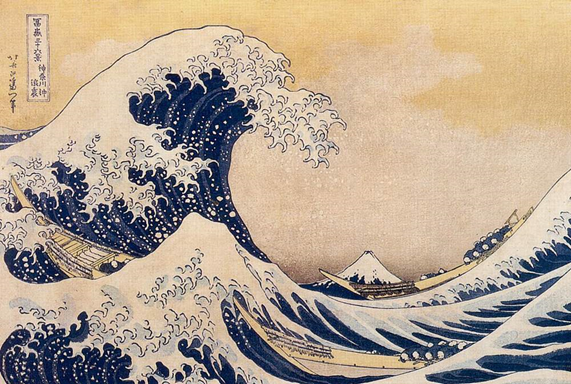
The image presents a print, The Great Wave off Kanagawa by Katsushika Hokusai. The work is approximately 9 by 15 inches. The image shows an enormous wave threatening boats off the coast of the Japanese town of Kanagawa. The composition comprises three main elements: the sea whipped up by a storm, three fishing boats, and a mountain, Mount Fuji itself, which appears in the distant background. The sea dominates the composition. In the moment captured, a massive cresting wave is pictured just moments before it is about to crash down on fishermen in their fishing boats. In the composition, the horizon is so low that it forces the viewer's eye to the very center of the action, giving the feeling that the awesome wave will break on top of the viewer.
23. In The Great Wave off Kanagawa, the relationship between humanity and nature is best described by the idea that people
- can control nature if they try.
- have degraded the natural environment.
- are dominated by nature.
- are moved by the sublime beauty of nature.
- Enter to expand or collapse answer.Answer expanded
- Option C is correct because the huge scale and force of the wave in comparison with the boats and people create a sense of nature as a dominant force. Option A is incorrect because the relation of the boats and people to the wave provide no sense of control. Option B is incorrect because it is irrelevant to the question. Option D is incorrect because although it is true that the concept of the sublime has been important in Japanese society, that idea is not depicted in this image.
Competency 010—The teacher recognizes and analyzes distinguishing characteristics of works of art from Africa, Asia and the Middle East from ancient times through the present.
24. Which of the following descriptions is generally characteristic of traditional Chinese painting?
- Theatrical subjects and bold, heavy outlines
- Linear perspective and dramatic chiaroscuro
- Religious subjects and strong, opaque colors
- Aerial perspective and calligraphic brush strokes
- Enter to expand or collapse answer.Answer expanded
- Option D is correct because aerial perspective and calligraphic brush strokes are hallmarks of Chinese painting, especially the landscape genre, which is traditionally regarded as the highest form of painting. Idealized scenes depicting towering mountains and water features are popular subjects in Chinese landscape painting which, like calligraphy, is often executed with a brush and ink on paper. Options A, B, and C are incorrect because none of the descriptions are characteristic of traditional Chinese painting.
Competency 011—The teacher recognizes and analyzes distinguishing characteristics of works of art from Australia, Oceania, Central America and South America from ancient times through the present.
25. Indigenous Australian art frequently focuses on the
- influence of ancestral beings.
- feats of individual rulers.
- protection of the unconscious.
- attainment of enlightenment.
- Enter to expand or collapse answer.Answer expanded
- Option A is correct because the influence of ancestral beings is frequently central to indigenous Australian art. Options B, C, and D are incorrect because indigenous Australian art does not focus on any of these concerns.
To answer the following question, please refer to the image of Andean ear ornaments reproduced below.
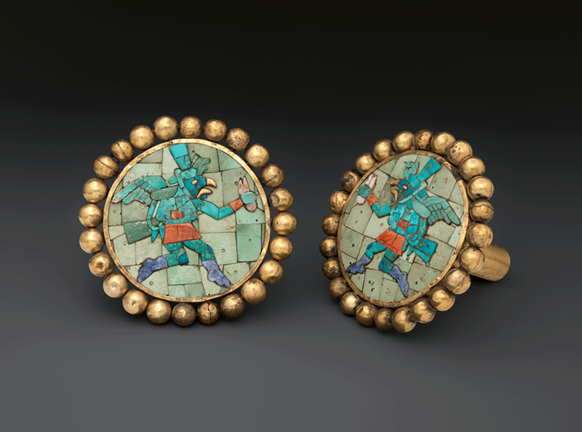
The image presents a pair of gold Moche earrings with nearly identical figural micromosaics depicting winged messenger/runners worked into the large circular frontals. Each ear ornament is approximately 3 by 3 inches. The mosaic imagery depicts a winged runner clutching a small cloth bag rendered in mother of pearl. The runners’ bird face is executed in a dark turquoise, with eyes and beaks sheathed in gold. A chin strap fastens an elaborate, tall headdress on to each runner’s head. Graceful wings stretch out from the behind the shoulders, and a rectangular element extending from the lower backs likely represent tail feathers. In contrast to the turquoise mosaic background, the figures wear bright orange bracelets and short skirts made of bright orange Spondylus shell. The figures’ body, arms, legs, and feet are suggestive of the human form. The kneecaps are a dark turquoise, and the lower legs and feet are picked out in a blue-colored mineral known as sodalite. The circumference of the frontals are encircled with small, hollow gold spheres made of sheet metal that frame the round composition.
26. The pair of Moche ear ornaments shown depict winged runners that are best characterized as
- illusionistic.
- zoomorphic.
- naturalistic.
- anthropomorphic.
- Enter to expand or collapse answer.Answer expanded
- Option D is correct because each ear ornament depicts a figure that combines the wings and head of a bird with human arms, legs, and body. The act of ascribing human characteristics to a non-human being is best characterized as anthropomorphic. Option A is incorrect because the work's subject is stylized, not illusionistic. Option B is incorrect because zoomorphic refers to the use of animal form or characteristics alone, without human features. Option C is incorrect because the subject matter is ornamental, not naturalistic.
Competency 012—The teacher recognizes and analyzes distinguishing characteristics of works of art from Europe from ancient times through the present.
27. Which of the following ancient societies portrayed the human figure in an idealized form?
- Greek
- Egyptian
- Aegean
- Chinese
- Enter to expand or collapse answer.Answer expanded
- Option A is correct because ancient Greek society did idealize the human figure, particularly during the Classical period. Options B, C, and D are incorrect; although each of these ancient societies had its own conven-tions for figurative representation, they did not engage in idealization as the Greeks did.
To answer the following question, please refer to the detail of Jan van Eyck's Ghent Altarpiece reproduced below.
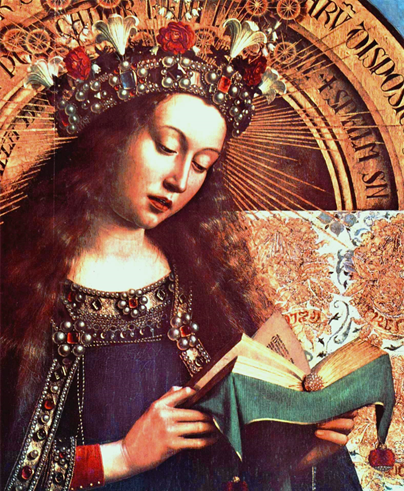
The image presents a detail of an interior panel of Jan van Eyck’s Ghent Altarpiece. The detail shows a portion of a portrait of the Virgin Mary. The work is rendered in oil paint on wood and has a luminous, enamel-like surface, rich, glowing colors, and highly realistic detail. Mary’s serene face is framed by long, wavy auburn hair as she gazes down upon a prayer book. She is dressed in a deep-blue robe and cape that is trimmed with a golden border, further embellished with pearls and jewels that shine with refracted light. She wears a bejeweled crown adorned with twelve stars and four identifiable types of flower, all of which were symbols relating to Mary. A halo of radiating rays of golden light emanates from her head. The Ghent altarpiece detail shown successfully blends naturalistic details with ornamental splendor in color and costume and intricate, painstaking details.
28. Which of the following is a characteristic of van Eyck's work that is evident in the image?
- Representations of classical subjects
- Depictions of stylized figures
- Use of painterly brushwork
- Rendering of minute detail
- Enter to expand or collapse answer.Answer expanded
- Option D is correct because van Eyck, along with contemporaries such as Rogier van der Weyden, is well known for his ability to paint minute details realistically. Options A, B, and C are incorrect because van Eyck did not paint classical subjects, depict stylized figures, or use painterly brushwork. In addition, none of these three characteristics can be seen in the image shown.
To answer the following question, please refer to the image of a poster by Henri de Toulouse-Lautrec reproduced below.
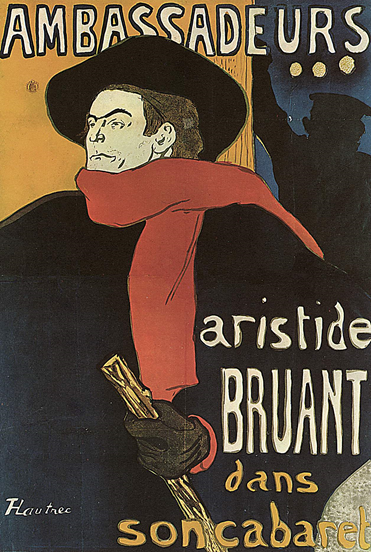
The image presents a printed poster, Ambassadeurs: Aristide Bruant by Henri de Toulouse-Lautrec. The work was created in 1892 and is approximately 57 by 39 inches. The poster was printed with six colors—olive base, yellow, red, blue, violet, and black—on wove paper. The subject of the poster is Toulouse-Lautrec’s friend, cabaret singer and Parisian celebrity Aristide Bruant, who was a popular singer, poet, and composer. Toulouse-Lautrec’s poster is advertising Bruant’s performance at Les Ambassadeurs, a chic Parisian nightclub. In the poster, Toulouse-Lautrec distilled Bruant’s personality into a few signature features, including his wide-brimmed black hat, bright red scarf, bulky black cape, walking cane, as well as his burly, theatrical swagger. The emphasis is on line and form, creating volume without shading, accentuating the subject matter by adopting large areas of flat colors, with fluid outlines describing the colored forms. The letter forms that advertise the performance appear to have been hand painted, expressively outlined in black and filled in with flat colors.
29. Henri de Toulouse-Lautrec used which of the following printing processes to create theatrical street posters, such as the artwork shown?
- Lithography
- Etching
- Silkscreen
- Woodcut
- Enter to expand or collapse answer.Answer expanded
- Option A is correct because Toulouse-Lautrec used lithography to create street posters. Options B, C, and D are incorrect printmaking processes with different characteristics than lithography; Toulouse-Lautrec did not use any of them to produce posters.
Competency 013—The teacher recognizes and analyzes distinguishing characteristics of works of art from North America from ancient times through the present.
30. The illustrations in the picture book Tar Beach by Faith Ringgold are based on her work with
- story quilts.
- encaustic paintings.
- heritage flags.
- glass mosaics.
- Enter to expand or collapse answer.Answer expanded
- Option A is correct because Ringgold, whose story quilts are a backbone of her work, adapted some for the illustrations in Tar Beach. Options B, C, and D are incorrect because the illustrations are not based on work in any of these media.
31. Which of the following painters received a commission in 1964 to create artwork for the interior of an interfaith chapel to be built in Houston, Texas?
- Clifford Still
- Mark Rothko
- Jackson Pollock
- Willem de Kooning
- Enter to expand or collapse answer.Answer expanded
- Option B is correct because, in 1964, private collectors Dominique and John de Menil commissioned Mark Rothko to create site-specific works for an interfaith chapel, subsequently named the Rothko Chapel, located in Houston, Texas. Options A, C, and D are incorrect because the painters listed did not receive this commission.
Domain III—Aesthetic Knowledge and Analysis of Art
Competency 014—The teacher understands the skills and knowledge that contribute to visual perception.
To answer the following question, please refer to the image of Monet's painting reproduced below.

The image presents a painting, Water Lilies by Claude Monet. The work was created in 1919 and is approximately 40 by 79 inches (almost seven feet wide). The painting shows a purple sunset sky and adjacent landscape reflected upon the mirrorlike surface of Monet’s pond at Giverny, France. That same year, he would create seventeen versions of this view at different times of day, in different conditions, each version displaying alternative, unique light and reflections. Monet achieves his signature atmospheric effects by using only loose, painted strokes of pure color. The parameters of the pond move beyond the edges of the frame, which crops out the horizon altogether, resulting in an immersive experience for the viewer.
32. Which of the following is demonstrated in the painting and reflects Monet's innovative approach to visual perception?
- Using only colors that have the same value
- Using strokes of color to represent the changing nature of light
- Using sharp shadows to indicate the exact time of day
- Using brushstroke patterns to demonstrate the movements of the painter's eye
- Enter to expand or collapse answer.Answer expanded
- Option B is correct because Monet's approach to visual perception, particularly of the ways in which light changes, is reflected in the way he used strokes of color. Options A and C are incorrect because they are not accurate descriptions of the painting. Option D is incorrect because there is no reason to believe that Monet ever considered this.
To answer the following question, please refer to August Macke's painting reproduced below.
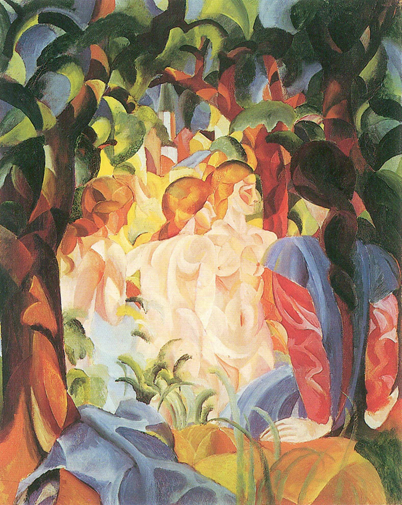
The image presents a painting, Girls Bathing with the Town in the Background by August Macke, created in 1913. In the center of the composition, three nude figures are painted in light tones that suggest drenching, bright yellow light. Their flesh-toned bodies are rendered with a prismatic treatment that also covers and transforms the entire painted surface into flat, geometric planes of color. This treatment incorporates semicircular shapes that fracture the figures and surroundings, creating recognizable yet stylized representations. Around the bathing figures are colorful stylized trees, rocks, and a clothed figure in the right corner, positioned with her back to the viewer. These outer areas use darker primary colors, shades of red, blue, and yellow, that create a vignette-like framing effect, emphasizing the importance of the bathing figures.
33. The treatment of form and space in the painting primarily demonstrates the influence of
- Surrealism.
- Impressionism.
- Cubism.
- Romanticism.
- Enter to expand or collapse answer.Answer expanded
- Option C is correct because the fracturing and flattening of space in the painting demonstrate the influence of Cubism. Options A, B, and D are incorrect because the painting does not reflect influences from any of those movements.
Competency 015—The teacher understands the skills and knowledge that contribute to visual literacy.
To answer the following question, please refer to the image of Leonardo da Vinci's fresco Last Supper reproduced below.
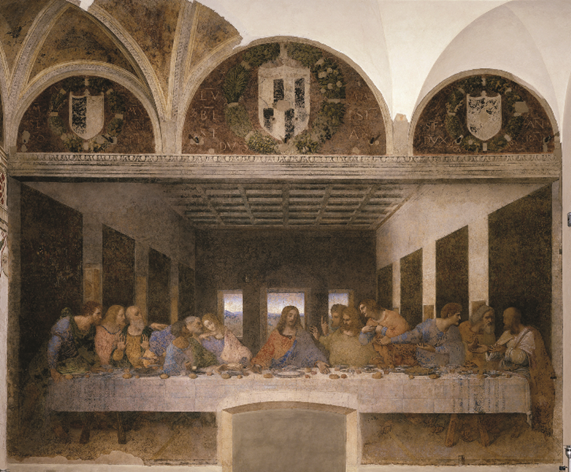
The image presents a wall painting, Last Supper, by Leonardo da Vinci. The work measures approximately 15 by 29 feet. Jesus Christ and his twelve apostles are shown assembled together. A long table covered in a white cloth stretches horizontally along the bottom third of the composition; all the figures are seated on the far side of the table with faces visible to the viewer. The composition is largely symmetrical. In the center of the group, the figure of Jesus appears as an equilateral triangle, anchoring the composition. His head is the focal point for the one-point linear perspective that da Vinci uses to create a sense of deep space and realistic, cohesiveness in the work. The twelve apostles are arranged on each side of Jesus as four groups of three, with the same number of figures on either side of Jesus. Last Supper specifically portrays the moment right after Jesus tells the group that one of them will betray him. All twelve apostles listen with different dramatic reactions to the news, and various degrees of anger, surprise, and shock can be seen in their facial expressions.
34. A primary goal of the painting was to
- critique corrupt practices within the church.
- attract attention and fame at a juried art exhibition.
- memorialize the scientific and literary achievements of a patron.
- break away from convention in dramatizing a religious narrative.
- Enter to expand or collapse answer.Answer expanded
- Option D is correct because Leonardo deliberately made changes from traditional Last Supper imagery, for example by placing Judas next to Christ, by using natural light around Christ's head instead of a halo, and by applying rigorous linear perspective. Option A is incorrect because the painting is not related to church policies or practices. Option B is incorrect because the painting had nothing to do with a juried art exhibition. Option C is incorrect because Leonardo's patron was not known for scientific or literary achievements and the imagery in the painting is Biblical.
To answer the following question, please refer to the image of Renoir's Dance at Bougival reproduced below.
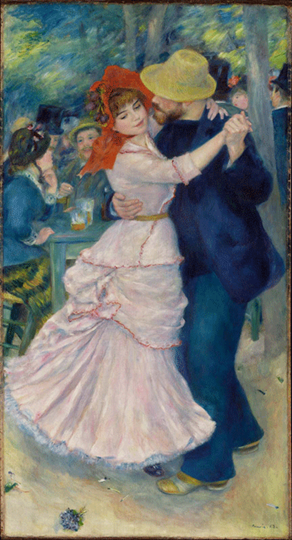
The image presents a painting, Dance at Bougival by Pierre-Auguste Renoir. The work was created in 1883 and measures approximately 72 by 39 inches. The composition shows a woman and man dancing together in a crowded open-air café. The painting is six feet tall, and the couple nearly fills the entire canvas. Three background figures are seated at a table to the left, and the heads of a few other dancing figures can be seen in the background to the right of the main subject. On the left, the young woman is wearing a swirling, full-length dress with layers of sheer pink, ruffled fabric piped in red. The woman’s face is shown in three-quarter view gazing to the side and downward, framed by her bright red bonnet. Her dance partner on the right is dressed in a deep navy-blue-colored suit. The upper portion of his face is hidden by the brim of a yellow fedora-style straw hat.
35. The colors used to portray the two dancing figures in the foreground of this painting have the effect of
- making the figures seem weightless and ethereal.
- creating a visual contrast between the two figures.
- suggesting a mood of stillness and melancholy.
- creating an ambiguous sense of depth and volume.
- Enter to expand or collapse answer.Answer expanded
- Option B is correct because the colors selected by Renoir to portray each figure—a warm, pale pink for the female dancer's dress and a dark navy blue for the male figure's suit—create strong visual contrast between them. Option A is incorrect because both figures are heavily modeled and do not appear weightless or ethereal, despite the female dancer's lacy dress. Option C is incorrect because a mood of stillness and melancholy is not evident in the work. Option D is incorrect because depth and volume are successfully conveyed and not ambiguous.
Competency 016—The teacher understands the basic principles of analysis, interpretation, and critique of works of art from various eras and societies.
36. Which of the following terms refers to the underlying meaning of a work of art based on its formal qualities and subject matter as well as the personal and sociological experiences of the viewer?
- Description
- Analysis
- Interpretation
- Judgment
- Enter to expand or collapse answer.Answer expanded
- Option C is correct because the question describes the meaning of interpretation. Options A, B, and D are incorrect because each refers to an aspect of criticism other than interpretation.
37. Barbara Kruger's artworks such as I shop therefore I am use appropriated imagery and text in a way that best aligns with which of the following approaches to analyzing works of art?
- Semiotic
- Iconographic
- Stylistic
- Psychoanalytic
- Enter to expand or collapse answer.Answer expanded
- Option A is correct because Barbara Kruger's conceptual collages reference modern society in order to examine and critique how we generate, comprehend, or attribute meaning to visual representations in society. These concerns share common ground with the principles of semiotic theory. Kruger explores postmodern themes such as consumerism, power, and control that would benefit most from semiotic analysis. Options B, C, and D are incorrect because iconographic, stylistic, and psychoanalytic approaches to art analysis do not provide the same breadth and depth of analysis that semiotic theory provides and that is needed to understand Kruger's body of work.
Domain IV—Art Education
Competency 017—The teacher understands the selection and use of curricula and instructional strategies for art education.
38. The art education model that plays down art production and fosters specific skills related to aesthetics, art criticism, and art history is
- discipline-based art education.
- visual culture art education.
- arts integration.
- choice-based art education.
- Enter to expand or collapse answer.Answer expanded
- Option A is correct because discipline-based art education (DBAE) is known for placing somewhat lessened value on art production and more for its inclusion of aesthetics, art criticism and art history. Options B, C, and D are incorrect because each of them refers to a different approach to art education that does not follow the DBAE model.
39. For a middle school lesson on rhythm, repetition and pattern, it would be most logical to connect those concepts to
- the choice of language in a well-known Shakespearean speech.
- a focused analysis of Leonardo's Vitruvian Man.
- an excerpt from the music of a classical composer such as Mozart.
- stop-action photographs of an Olympic diver completing a dive.
- Enter to expand or collapse answer.Answer expanded
- Option C is correct because classical music such as Mozart's has rhythm and repeats motifs, creating patterns. Option A is incorrect because although Shakespearean speeches have a conscious rhythm, this is not directly related to the choice of words and the language typically does not repeat. Option B is incorrect because the Vitruvian Man is concerned primarily with proportion rather than rhythm, repetition, or pattern. Option D is incorrect because it might include rhythm, through the repeated images of the diver; the position of the diver would change and would not create a pattern.
40. Of the following techniques and media, the best choice for a classroom with young students who are blind or have extremely limited sight is
- blending with pastels.
- crosshatching with pencils.
- sculpting with modeling clay.
- printmaking with linoleum.
- Enter to expand or collapse answer.Answer expanded
- Option C is correct because the tactile experience of working with modeling clay makes it accessible to students with very limited vision. Options A, B, and D are incorrect because each of them would require a higher level of sight.
Competency 018—The teacher understands lessons and activities that develop the thinking skills students need to create, evaluate and appreciate artworks.
41. Which of the following art history activities would most likely help a middle school class develop the ability to make informed judgments about artwork from a variety of times and cultures?
- Asking the class to vote for its favorite work among a group of related works that are displayed in the classroom
- Defining the principles of design and then giving the class a written quiz about the principles
- Displaying a group of related works from various cultures and leading a discussion of how similar content is represented in each one
- Having each student in the class create a personal symbol, paint it with tempera paint, and write a paragraph explaining its meaning
- Enter to expand or collapse answer.Answer expanded
- Option C is correct because the kind of discussion described would provide students with contextual as well as visual information about the work. Option A is incorrect because asking for the students' intuitive preferences would not help them in this situation. Option B is incorrect because, like option A, it would not lead to informed judgments about a range of art. Option D is incorrect because it remains within the realm of the students' personal interests and opinions.
Competency 019—The teacher understands lessons and activities that develop the productive skills students need to create artworks.
42. To ensure that art materials are not toxic, art teachers should look for
- donated and found materials.
- materials with an AP label from the ACMI.
- materials with a CL label from the ACMI.
- water-based materials only.
- Enter to expand or collapse answer.Answer expanded
- Option B is correct because the AP label from ACMI certifies that the material is safe. Option A is incorrect because such materials could easily include some that are toxic. Option C is incorrect because the CL seal from ACMI certifies that the material does carry the risk of some toxicity. Option D is incorrect because water-based materials as a group do not ensure safety.
43. Which of the following activities would best help students to make informed decisions about their works in progress?
- Asking students to write reflective self-assessments when the work is complete
- Holding formative critiques to discuss progress, problems and possible solutions
- Requiring students to keep careful logs of the time spent working on an assignment
- Giving students a rubric that explains the criteria that will be used in grading
- Enter to expand or collapse answer.Answer expanded
- Option B is correct because holding a classroom critique midway through an art project provides valuable classroom feedback and models the kind of higher-order thinking needed for students to make informed decisions while creating artworks. Option A is incorrect because a self-assessment made after the work is complete would not be as useful for works in progress. Option C is incorrect because keeping careful logs of time spent would not be the best way to teach students about making informed creative decisions while creating works of art. Option D is incorrect because focusing on grading criteria is not the best way for students to make informed decisions about art making.
Competency 020—The teacher understands reading and study strategies that contribute to learning in the visual arts.
44. Of the following methods of presentation, which would be most effective for a high school teacher who wants all students to see the same set of visual examples?
- Providing access to several websites that have relevant images
- Projecting a digital slide show on a screen while the class watches
- Passing around books that each contain some of the images, with the relevant pages marked
- Circulating a stack of individual reproductions of the images for the students to each view
- Enter to expand or collapse answer.Answer expanded
- Option B is correct because it ensures that all students who are paying attention will see the same examples. Options A, C, and D are incorrect because in each case, students might not see all of the images.
Competency 021—The teacher understands the basic principles and approaches for assessment in art education.
45. If a teacher is required to assign a letter grade to student artwork, the most responsible way to arrive at the grade is to do which of the following?
- Intuitively sort students' artwork into various piles by level of achievement and then assign a letter grade to the work in each pile.
- Organize the artwork on tables from most to least successful and then decide where to place the line between each letter grade.
- Assign a total number of possible points and then deduct points for any unsatisfactory aspects in the artwork.
- Use a predetermined rubric with criteria for each letter grade and then decide which set of criteria best fits each individual artwork.
- Enter to expand or collapse answer.Answer expanded
- Option D is correct because a rubric with criteria for each letter grade will provide the most consistent and fairest grading of the choices. Options A, B, and C are incorrect because they all rely to a greater or lesser extent on more subjective judgment.
46. Which of the following questions, if included in a high school student's self-assessment, would best reveal student growth after the completion of an art assignment?
- Did you enjoy the assignment? Why or why not?
- How long did the assignment take to complete? Was the time allowed reasonable?
- What is the subject matter of the work you created for the assignment? Where did you get this idea?
- What new strategy or technique did you try in the assignment? How was this attempt successful or unsuccessful?
- Enter to expand or collapse answer.Answer expanded
- Option D is correct because the process of reflecting on one's own successes or difficulties with a new strategy or technique is a way of analyzing what one has learned from the experience and thus how one has grown. Options A and B are incorrect because they are not generally linked to student growth. Option C is incorrect because subject matter, as opposed to process, content, or concept, is relatively unlikely to reflect growth; this is also true of the source of the idea.
47. The method of assessment most suitable for evaluating expressive learning is
- standardized testing.
- state competency testing.
- performance assessment.
- personality assessment.
- Enter to expand or collapse answer.Answer expanded
- Option C is correct because performance assessment is the method that is most suitable for the assessment of expressive learning in the arts. Options A, B, and D are incorrect because none are an ideal choice for best evaluating expressive learning in the arts.
Competency 022—The teacher understands career choices, avocations and professional development available in the visual arts.
48. To promote district support for a school's art program, it is most appropriate for a teacher to take which of the following actions?
- Display the winning work from a student-run art contest in the school hallway.
- Post images of students working in art class on a social networking website.
- Make a presentation of representative student artwork to the school board.
- Allow gifted students to come to the art room during their lunch period.
- Enter to expand or collapse answer.Answer expanded
- Option C is correct because school board members have a direct influence on issues such as budget allocations; making a presentation to them is a logical advocacy activity. Options A and D are incorrect because they focus entirely on students whose ability is seen as unusually strong. Option B is incorrect because it is inappropriate and may be illegal to post images of students on any social networking website without their or their guardians' written consent.
Multiple-Competencies Passage
To answer questions 49–50, please refer to the detail of an Egyptian scroll reproduced below.
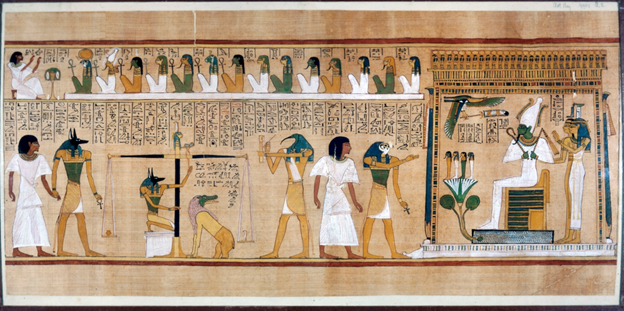
The image presents an Egyptian scroll, measuring approximately 16 by 35 inches. The substrate of the scroll is a thin material that appears tan colored with a subtle woven textured surface. Dark red borders run horizontally along the top and bottom. At the top, a white-garbed figure (an Egyptian scribe) kneels in adoration before crouching Egyptian deities lined up along a white horizontal line. Below this scene, a series of larger figures are depicted walking, sitting, or standing along the bottom border. The figures are shown with their face, waist, and limbs in profile, but hips and shoulders are facing frontally, with no overlapping of figures. Reading from left to right, the main scene shows the same Egyptian scribe figure encountering various Egyptian gods. The jackal-headed Anubis leads the scribe by the hand toward balancing scales, where Anubis appears again, kneeling while adjusting the balance. On the left scalepan is a human heart and on the right the feather hieroglyph. Below the scales crouches the crocodile-headed goddess Ammit. To the right of the scales, Thoth, the ibis-headed god, holds a pen and scribal palette. Continuing reading to the right, the scribe is brought into the presence of Osiris by his son Horus. Osiris is shown enthroned under a canopy, with his sisters Isis and Nephthys standing behind him. The lines of inscription above the scene contain passages of hieroglyphics.
Competency 008—The teacher understands how the visual arts shape and reflect history and different societies.
49. The imagery in the detail shown refers to
- events after death.
- a royal parade.
- arguments among gods.
- performance of a play.
- Enter to expand or collapse answer.Answer expanded
- Option A is correct because the imagery depicts events in the journey of the soul after death. Religious imagery (including this detail) composed the majority of ancient Egyptian painted works. Options B, C, and D are incorrect because none of them is depicted in the detail shown.
Competency 010—The teacher recognizes and analyzes distinguishing characteristics of works of art from Africa, Asia and the Middle East from ancient times through the present.
50. The detail shown is part of an Egyptian scroll made of
- papyrus.
- silk.
- canvas.
- ivory.
- Enter to expand or collapse answer.Answer expanded
- Option A is correct because this scroll, as was common in ancient Egypt, is made of papyrus. Options B, C, and D are incorrect because none of them was commonly used as a painting surface in ancient Egypt.
Acknowledgments
1. Romare Bearden. Art © Romare Bearden Foundation / Licensed by VAGA, New York, N.Y. / Photo Credit: Albright-Knox Art Gallery / Art Resource, N.Y.
2. Public Domain.
10. Vincent van Gogh. Image kindly provided by zeno.org.
11. Melvin Edwards. The Fourth Circle, 1966. Los Angeles County Museum of Art, Los Angeles, California. U.S. Digital Image © 2013 Museum Associates / LACMA. Licensed by Art Resource, N.Y.
14. Walters Art Museum.
23. Katsushika Hokusai. Image kindly provided by zeno.org.
26. Public Domain.
28. Jan van Eyck. Image kindly provided by zeno.org.
29. Henri de Toulouse-Lautrec. Image kindly provided by zeno.org.
32. Claude Monet. Image kindly provided by zeno.org.
33. August Macke. Image kindly provided by zeno.org.
34. Leonardo da Vinci. Scala/Ministero per i Beni e le Attività culturali / Art Resource, N.Y.
35. Renoir. Public Domain.
49–50. Egyptian Scroll © The Trustees of the British Museum/ Art Resource, N.Y.